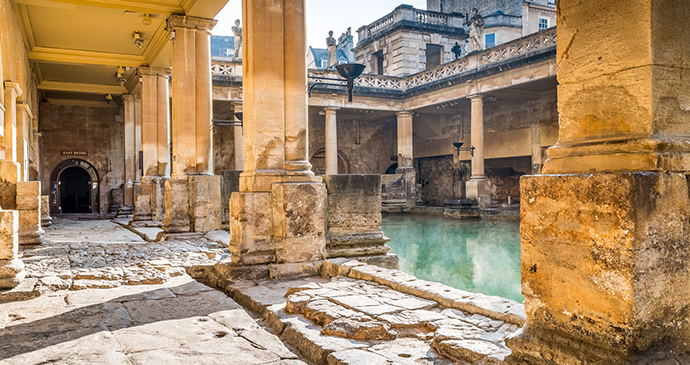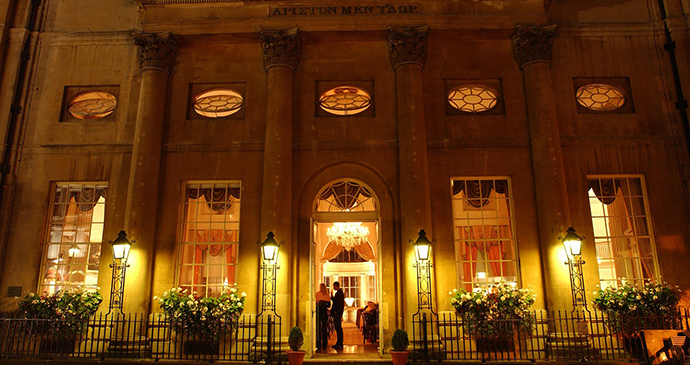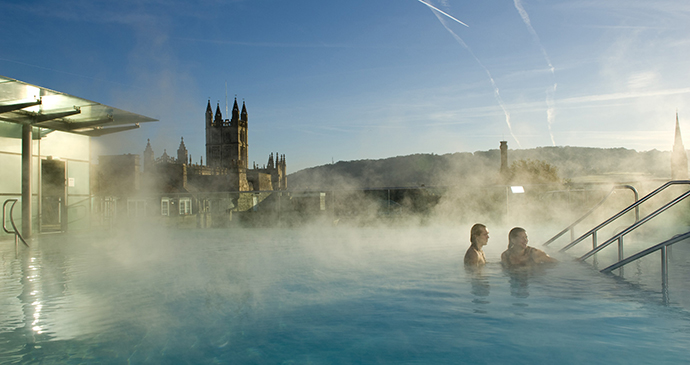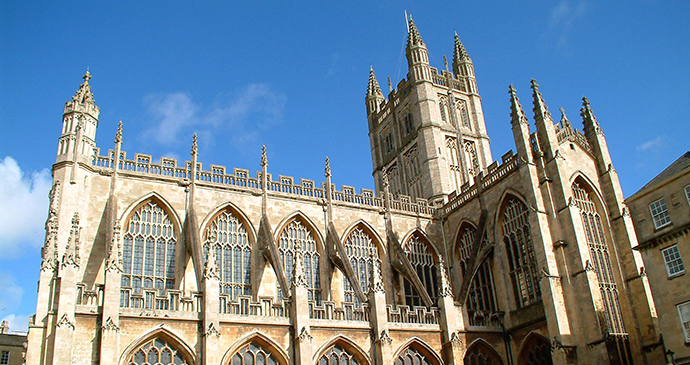Roman Baths
The Pump Room
Thermae Bath Spa
Bath Abbey
Guildhall Market & Victoria Art Gallery
Before Bath reinvented itself in the 18th century by creating wide, fashionable avenues, it had a network of small alleyways and streets. There’s little truly medieval in Bath such was its sweeping out of the past, but a few streets close to Bath Abbey give an impression of life in the city before its reincarnation. With tiny shopfronts and not-so-high buildings, they provide a fascinating change to the Palladian style of Georgian Bath. Many of the streets around Bath Abbey are pedestrianised, so make the most of this walking territory and spend a morning ambling from shop to shop.
Roman Baths
Naturally the largest of the baths, the Great Bath still impresses regardless of how many times you look at it in tourist literature.
Arguably the beating heart of Bath, the Roman Baths is where one of the hot springs that have attracted people for millennia bubbles to the surface. It took up to 10,000 years for the water that once fell on the nearby Mendip Hills to drift down through limestone caves and then push to the surface again; since surfacing it has reached a natural temperature of 46˚C with a flow of approximately 250,000 gallons of water per day.
Before you reach the actual baths, you encounter an exhibition on life in the Roman city and the reasons people set up home here. The powerful imagery of the Temple of Sulis Minerva, the goddess they came to worship, is portrayed against a wall, her piercing gaze locking onto anyone in the room. Gravestones, tools, money and an attractive mosaic (actually found in a house nearby) bring the history to life.

I found the explanations of the pre-Roman history the most enlightening, imagining prehistoric times when the inhospitable area was marshy, the valley wooded and how mysterious and potent the landscape with these hot, bubbling springs must have seemed for those coming to worship the Celtic goddess of Sulis.
You do have to use every power in your imagination to take you back to Roman times. As one of the most visited attractions in Britain, the baths are constantly busy with people clicking away at the buttons of audio guides. I find the best place to appreciate what these baths are all about – why they are special – is the Roman Spring Overflow, where surplus water from the Sacred Spring (seen bubbling in the King’s (Bladud’s) Bath on your way around) pours into a Roman-built drain before flowing into the river close by. It’s hot and steamy there with the intense pressure and volume – and noise – of the water.
Naturally the largest of the baths, the Great Bath still impresses regardless of how many times you look at it in tourist literature. Don’t be fooled by the building or the ‘Roman’ figures that line the terrace above though: the building is 18th century and the statues are actually late 19th century, put in place when the baths were uncovered and opened to the public for the first time. The terrace is, however, an inspirational place from which to view the abbey next door.
A truly magical experience is to view the Roman Baths in the evening, when the rooms and pools are lit up by torchlight as darkness falls. During July and August the baths are open until 21.00 (last entry).
The Pump Room
Elegance is the word to sum up the Pump Room. Its very nature makes you sit up straight.
The 43 minerals within the water, which apparently cured Bladud, were deemed to have healing properties and new medical ideas in the late 17th century made ‘taking the water’ extremely fashionable. For this purpose, a Pump Room was opened in 1706 and Beau Nash, Bath’s master of ceremonies, turned the building into a fashion icon. The vast, high-ceilinged room that you see today is the work of massive alterations in 1796 to accommodate all the new residents – Bath’s population exploded from 2,000 to 38,000 during the late 18th century.
Taking tea in the Pump Room is an attraction in its own right, but this is still the place to take the waters and if you’ve paid to visit the Roman Baths then you are entitled to a free glass of spa water. It’s pumped direct from the bubbling King’s Spring below into an elegant urn placed reverently in the bow of a giant window. ‘Do I have to drink it all?’ I asked the waitress meekly. Memories came flooding back of struggling with a glass of the very same sulphurous-cum-ferrous-tasting liquor in a show of macho Britishness to a French exchange student years before. ‘Not if you don’t want to, but it’s good for you!’ replied the matronly figure. It may not be the most elegant approach to drinking a glass of water in such an esteemed location, but my best advice is to ‘down it’ so that the drink barely touches the sides – the water has an undeniably revolting taste.

The alternative is to ‘dine’ in the Pump Room, when a lemon or strawberry syrup can be added to disguise it. Or do as I did and eat a Bath bun, designed for the very job of hiding the taste of the spring water. (A Bath bun is a little like a toasted teacake with currants and crystallised sugar on the top, served with cinnamon butter.)
Elegance is the word to sum up the Pump Room. Its very nature makes you sit up straight. The giant chandelier – taller than the height of most people’s living rooms – sparkles across the hall, while the dashing figure of Beau Nash, holding his set of etiquette rules, peers down from the wall as if to make sure that you are holding your teacup correctly and keeping your elbows off the table. I cast an ear to the bow-tied Pump Room Trio, feeling some sense of connection in the room; this was where my grandfather held one of his first jobs as a conductor in the 1930s, leading the Pump Room Orchestra, allegedly one of the oldest established ensembles in the British Empire, founded by Beau Nash.
Thermae Bath Spa
Bathing here for an afternoon, or an evening as the sun goes down with the lights illuminating the abbey, has to be one of the best ways to enjoy the Cotswolds slowly.
It’s all very well looking at where the Romans enjoyed a bathe, but the spa waters still hold their therapeutic properties and Bath retains its fashionable status as a spa town. From the Roman baths, wander down Bath Street (the only double-colonnaded street in Britain) and at the far end, directly in front of you, you’ll come to the Cross Bath and, to your left, the modern-day, glass-caged Thermae Bath Spa, promoting itself as ‘Britain’s original natural thermal spa’.

It’s not a practice I indulge in often but, mindful of a potential passing car, I can’t help but stand in the middle of Hot Bath Street outside the spa entrance and put my hand to the manhole cover there. The cover feels warm (even if the day isn’t) and you can hear the gushing of the Hot Spring beneath your hand.
Opposite is the open-air Cross Bath, an intimate thermal pool enclosed by a World Heritage Site Georgian shell, where bathers can book the entire facility for private use. Inside the main glass-fronted spa building, numerous pools, steam rooms and treatment rooms all use the healing powers of the naturally heated waters to send visitors into a trance-like state of relaxation. The smell, by the way, is sweet-scented and nothing like that of the spa water I’d drunk previously. But of all the alluring hot pools, massage jets, frankincense-infused steam rooms and body-wraps, the most inviting has to be the open-air rooftop pool. ‘Beauty heals,’ said my guide, and the views of the city, the abbey and the green pastures beyond, which can all be seen while lying back in the steaming pool, are certainly stunning. It may be all in the mind rather than the water, but bathing here for an afternoon, or an evening as the sun goes down with the lights illuminating the abbey, has to be one of the best ways to enjoy the Cotswolds slowly.
Bath Abbey
The carving is mind-blowing in detail and fragility, like a fine lace or ivory crochet.
The history of Bath Abbey is described in an extensive exhibition in the Vaults Museum beneath this illustrious building, so I don’t feel the need to repeat it here. Instead I’d prefer to focus on something that really caught my eye in a building that’s so immense in scale and craftsmanship that you need to concentrate on selected aspects of it so as not to become punch-drunk.

It’s the stone carving behind the high altar, beneath the dazzling east window. The carving is mind-blowing in detail and fragility, like a fine lace or ivory crochet. Knitting-needle columns progress to fan-shaped arches of graceful proportions, Gothic arches frame intimately carved reliefs and above are borders of leaves and flowers so soft and delicate they can’t possibly be created from something as hard as stone. It made me look closer to seek out an accidental slip of the chisel that needed to be covered up, and wonder how much the stone carver swore and groaned at the prospect of a job so intricate, where tiny birds hidden among the leaves are carved so that you can see the eye and the tip of the beak.
Guildhall Market & Victoria Art Gallery
Look at the market building from the opposite side of the neighbouring river and you can see the windows and doors of the old market vaults, the slaughterhouses and the stables that run beneath Grand Parade.
Just to the north of the abbey, one large Georgian building separates the High Street from Grand Parade and the River Avon. In it is the prestigious Guildhall, used for weddings and events, the covered market and the Victoria Art Gallery. The Guildhall Market is already special before you’ve even entered: just look at the domed building in which it’s housed and the ornamental gates at the two entrances; a passageway runs right through the market linking the two streets on either side. There’s been a market on the site for 800 years – Bath was also a ‘wool town’ at one stage (Chaucer’s ‘Wife of Bath’ is ‘an expert in cloth making’) – although much of the internal infrastructure, such as the original weighing room, has disappeared. But look at the market building from the opposite side of the neighbouring river and you can see the windows and doors of the old market vaults, the slaughterhouses and the stables that run beneath Grand Parade, held up by a sturdy stone colonnade.
Still run as a traditional market, it is full of atmosphere with a good old-fashioned mix of little ‘shops’ inside. One of the bye-laws for 1864 caught my eye: ‘No person shall throw or fling vegetables, garbage or any missile in the market.’
Next door, but with an entrance in Bridge Street, is the Victoria Art Gallery, one of two free-to-enter museums in Bath. There are three centuries of British paintings on display from artists including Gainsborough, Constable and Sickert plus some fascinating local scenes, such as The Royal Crescent by Joseph Farringdon. The picture is painted from the river sometime after 1775 and, while we associate this landmark to be in the centre of the city today, in the painting there are no buildings between the river and the Crescent.
The gallery gives excellent background detail about each painting and artist and reminds us that most artists were in Bath to make a living. As a portrait painter Gainsborough, for example, realised that Bath was a good place in which to make a living as many wealthy spa visitors were keen to have their portrait painted during their stay. He did very nicely from the tourist trade, living and working in the city from 1759 until 1774, first at a very grand house close to the Pump Room and later at one of the finest addresses in the city: The Circus.